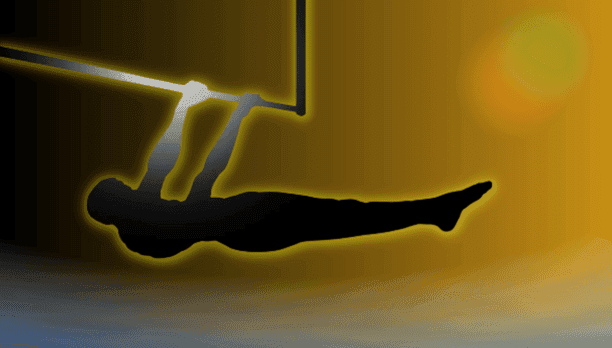The front lever is one of the most impressive and challenging calisthenics skills you can master. This horizontal hold requires exceptional core strength, back development, and body control. In this comprehensive guide, we’ll break down the front lever progression from beginner to advanced, providing you with the knowledge and training methods needed to achieve this impressive static hold.
Table of Contents
What Is a Front Lever?
The front lever is an advanced static hold where your body is suspended horizontally from a bar with arms straight, forming a straight line from head to toe. Your back faces the ground while maintaining a rigid position parallel to the floor. This isometric exercise primarily targets your lats, core, and shoulders while engaging nearly every muscle in your body.
When performed correctly, the front lever demonstrates exceptional relative strength and body control. It’s a staple skill in gymnastics, calisthenics competitions, and advanced bodyweight training routines.
Muscles Worked in the Front Lever
Understanding the muscle engagement in a front lever will help you train more effectively:
- Primary muscles: Latissimus dorsi (lats), rectus abdominis, obliques, serratus anterior
- Secondary muscles: Rhomboids, trapezius, deltoids, pectorals, biceps, forearms
- Stabilizers: Erector spinae, glutes, hamstrings, quadriceps
The front lever is particularly effective for developing your “pulling” muscles while simultaneously strengthening your core. This combination makes it an excellent exercise for overall upper body development and core stability.
Prerequisites Before Starting Front Lever Training
Before attempting the front lever progression, ensure you have:
- The ability to perform at least 8-10 clean pull-ups
- Strong core fundamentals (able to hold a hollow body position for 30+ seconds)
- Decent scapular control and retraction strength
- No current shoulder or lower back injuries
If you’re not quite there yet, focus on building these foundational elements first. The front lever requires significant strength, and attempting it prematurely could lead to injury or frustration.
Complete Front Lever Progression Path
Follow this step-by-step progression to achieve your first front lever. Each stage builds the necessary strength and body awareness for the next level.
1. Dead Hang with Scapular Retraction
Before attempting any front lever variations, master the active hang:
- Hang from the bar with arms fully extended
- Pull your shoulder blades down and back (scapular retraction)
- Maintain this engaged position for 20-30 seconds
- Focus on creating tension throughout your upper back
This foundational position teaches proper shoulder positioning and back engagement crucial for all front lever variations.
2. Tucked Front Lever
The tucked front lever is your first step toward the full position:
- Start in a hanging position with active shoulders
- Pull your knees toward your chest in a tight tuck
- Lean back and pull the bar toward your hips
- Aim to get your back parallel to the ground while maintaining the tuck
- Hold for 10-20 seconds, focusing on keeping your shoulders depressed
Work on this position until you can hold a clean tucked front lever for at least 15-20 seconds for multiple sets.
3. Advanced Tucked Front Lever
This variation increases the leverage challenge:
- Start in the tucked front lever position
- Extend your hips slightly while keeping knees bent
- Maintain a flat back and engaged core
- Your thighs should be roughly parallel to the ground
- Hold for 8-15 seconds
The advanced tuck increases the lever length while still providing some mechanical advantage compared to the next progressions.
4. Single-Leg Front Lever
Now we’ll begin extending one leg at a time:
- Start in the advanced tucked position
- Slowly extend one leg completely while keeping the other tucked
- Maintain a straight body line from head through the extended leg
- Hold for 5-10 seconds
- Practice with both legs to ensure balanced development
This asymmetrical position helps bridge the gap between tucked and straddle variations while building unilateral strength.
5. Straddle Front Lever
The straddle position significantly increases the difficulty:
- Begin in a tucked front lever
- Extend both legs outward in a wide straddle position
- Keep your legs straight and toes pointed
- Maintain a flat back and engaged core
- Hold for 5-8 seconds, focusing on body alignment
The straddle front lever is approximately 80-85% as difficult as the full front lever, making it an excellent preparatory position.
6. Half-Lay Front Lever
This variation brings your legs closer together:
- Start in the straddle front lever position
- Gradually bring your legs closer together (about halfway between straddle and full)
- Maintain straight legs and proper back position
- Hold for 3-6 seconds
The half-lay increases the leverage challenge as your legs move closer to the full position.
7. Full Front Lever
The complete front lever position:
- Hang from the bar with active shoulders
- Pull your body up while leaning back
- Extend your legs fully, keeping them together
- Create a straight line from hands to toes, parallel to the ground
- Maintain tension throughout your entire body
- Hold for as long as possible while maintaining proper form
Congratulations! Achieving a full front lever puts you in an elite category of strength athletes.
Effective Front Lever Training Methods
To make consistent progress, incorporate these training methods into your routine:
Isometric Holds
The primary method for developing front lever strength:
- Perform 3-5 sets of maximum-duration holds at your current progression level
- Rest 2-3 minutes between sets
- Train 2-3 times per week with at least 48 hours between sessions
- Progress to the next level when you can hold your current position for 10+ seconds across multiple sets
Dynamic Front Lever Exercises
These movements build strength through the full range of motion:
Front Lever Raises
- Start in a dead hang
- Pull into your current front lever progression
- Lower back to dead hang with control
- Perform 3-4 sets of 5-8 repetitions
Ice Cream Makers
- Begin in a front lever position (at your current progression level)
- Pull your chest to the bar while maintaining body position
- Return to the front lever position
- Lower back to hang
- Perform 3-4 sets of 5-8 repetitions
Supplementary Exercises
These exercises strengthen the specific muscles needed for the front lever:
- Weighted Pull-ups: 3-4 sets of 5-8 reps
- Hollow Body Holds: 3 sets of 30-60 seconds
- Straight-Arm Lat Pulldowns: 3 sets of 10-12 reps
- Inverted Rows: 3-4 sets of 8-12 reps
- Dragon Flags: 3 sets of 5-8 reps
Incorporate these supplementary exercises 1-2 times per week to build the specific strength needed for front lever mastery.
Common Front Lever Mistakes and How to Fix Them
Avoid these common errors to ensure safe and effective progress:
Arched Back
Problem: Excessive lower back arching reduces core engagement and increases injury risk.
Solution: Strengthen your hollow body position and focus on posterior pelvic tilt during training.
Elevated Shoulders
Problem: Shoulders rising toward ears indicates insufficient scapular depression.
Solution: Practice active hangs and scapular pull-ups to strengthen proper shoulder positioning.
Bent Arms
Problem: Bending the elbows makes the lever easier but develops improper technique.
Solution: Return to an earlier progression and focus on maintaining straight arms throughout the hold.
Hips Sagging
Problem: Hips dropping below the horizontal plane indicates insufficient core strength.
Solution: Incorporate more hollow body training and dragon flags to strengthen your core.
Sample Front Lever Training Program
Here’s a 12-week program to develop your front lever:
Weeks 1-4: Foundation Building
2-3 times per week:
- Active Hangs: 3 sets of 20-30 seconds
- Tucked Front Lever: 4 sets of max hold (aim for 10-15 seconds)
- Hollow Body Hold: 3 sets of 30-45 seconds
- Pull-ups: 3-4 sets of 6-10 reps
- Inverted Rows: 3 sets of 10-12 reps
Weeks 5-8: Intermediate Development
2-3 times per week:
- Advanced Tucked Front Lever: 4 sets of max hold
- Tucked Front Lever Raises: 3 sets of 5-8 reps
- Single-Leg Front Lever Attempts: 3-4 sets of 5-8 seconds per side
- Weighted Pull-ups: 3-4 sets of 5-8 reps
- Dragon Flags: 3 sets of 5-8 reps
Weeks 9-12: Advanced Progression
2-3 times per week:
- Single-Leg/Straddle Front Lever: 4 sets of max hold
- Ice Cream Makers: 3 sets of 5-8 reps
- Front Lever Negatives: 3-4 sets of 3-5 controlled lowerings
- Full Front Lever Attempts: 2-3 sets of maximum duration
- Straight-Arm Lat Pulldowns: 3 sets of 10-12 reps
Adjust the program based on your progress. If you’re advancing quickly, you can move to the next phase sooner. If you need more time at a particular stage, extend that phase by 2-4 weeks.
Nutrition and Recovery for Front Lever Training
Proper nutrition and recovery are crucial for front lever progress:
Nutrition Tips
- Maintain adequate protein intake (1.6-2.0g per kg of bodyweight)
- Eat sufficient calories to support strength gains
- Consider a slight caloric deficit if weight loss would benefit your strength-to-weight ratio
- Stay hydrated, especially before and during training
- Time carbohydrate intake around workouts for optimal energy
Recovery Strategies
- Allow 48-72 hours between intense front lever sessions
- Prioritize 7-9 hours of quality sleep
- Incorporate active recovery days with mobility work
- Consider deload weeks every 4-6 weeks of intense training
- Use foam rolling and stretching to maintain shoulder and back mobility
Front Lever Variations and Advanced Techniques
Once you’ve mastered the basic front lever, challenge yourself with these variations:
One-Arm Front Lever
An extremely advanced variation where you hang from one arm while maintaining the front lever position.
Front Lever Pull-ups
Perform a pull-up while maintaining the front lever position throughout the movement.
Weighted Front Lever
Add weight using a vest or ankle weights to increase the difficulty of your front lever hold.
L-Sit to Front Lever
Transition smoothly from an L-sit to a front lever position, demonstrating control through different leverage points.
Front Lever on Rings
Performing the front lever on gymnastic rings adds an additional stability challenge.
FAQs About the Front Lever
How long does it take to achieve a front lever?
Most dedicated trainees require 6-18 months of consistent practice to achieve a full front lever, depending on starting strength, body proportions, and training frequency. Taller individuals and those with longer limbs typically require more time.
Is weight an important factor for the front lever?
Yes, the front lever is a leverage-based movement where your strength-to-weight ratio is crucial. Reducing body fat while maintaining muscle mass can significantly improve your front lever performance.
How often should I train the front lever?
For optimal progress, train front lever-specific exercises 2-3 times per week with at least 48 hours between sessions. More frequent training often leads to overtraining and slower progress.
Should I train front lever if I have shoulder pain?
No, address any shoulder issues before beginning front lever training. The significant demands on shoulder stability can exacerbate existing problems. Consult with a physical therapist if you have concerns.
Can women achieve the front lever?
Absolutely! While women typically have different strength-to-weight distributions than men, many female athletes achieve impressive front levers through dedicated training.
Conclusion
The front lever represents one of calisthenics’ most impressive demonstrations of strength, control, and body awareness. By following this systematic progression and training consistently, you’ll develop exceptional upper body and core strength while working toward this impressive skill.
Remember that progress takes time—celebrate the small victories along the way and trust the process. Each progression builds the necessary strength for the next level. Stay patient, train smart, and you’ll eventually achieve this impressive calisthenics skill.
Have you been working on your front lever? Share your progress and questions in the comments below!
Looking to improve other calisthenics skills? Check out our guides on handstand progression, improving pull-ups, and dragon flags.

Founder of www.calisthenics-101.co.uk. Training calisthenics since 2012.
Currently working on: 30 second one-arm handstand, muscle-up 360, straddle planche.
